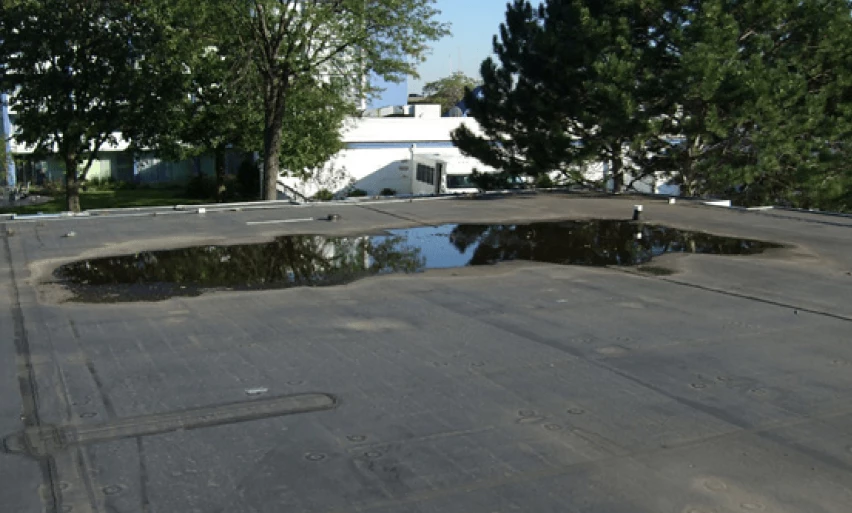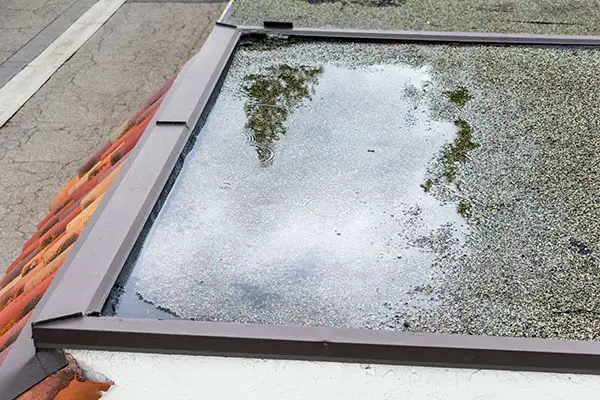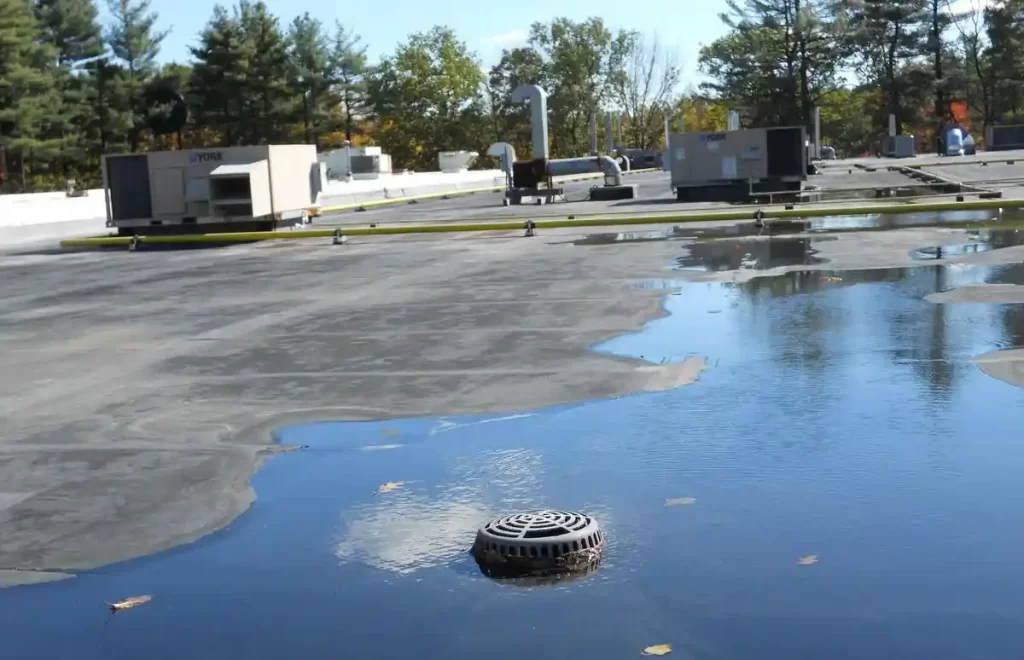Roof ponding, a common issue in commercial roofing, occurs when water collects in low-lying areas on a flat or low-slope roof and doesn’t drain properly. It can result from various factors like poor installation, structural problems, or debris accumulation. This standing water may seem harmless, but it can lead to serious problems. Over time, it weakens the roof’s integrity, causes leaks, and promotes the growth of mold and algae. Furthermore, the added weight of ponding water can strain the roof’s structure. Understanding roof ponding and its effects is crucial for maintaining the longevity and efficiency of commercial roofs, as Authentic Roofing will explore in this guide.
Signs of Roof Ponding:
Recognizing signs of commercial roofing ponding is essential for maintaining the health of your commercial roof. One key indicator is the presence of standing water on the roof for an extended period, typically 48 hours or more after rain. This stagnant water is often seen in low-lying areas where drainage is inadequate. Another visual clue is a sagging appearance in certain areas of the roof, indicating a potential problem. In some cases, you might notice a noticeable tilt in the roof surface, which can divert water towards particular sections. Keeping an eye out for these telltale signs allows you to address ponding issues promptly and prevent further damage to your commercial roof, ultimately saving you from costly repairs and ensuring a more extended roof lifespan.



Insulation Damage:
Insulation damage is a common consequence of roof ponding, and it’s crucial to understand its implications for your commercial roof. When water accumulates on the roof due to ponding, it can gradually saturate the insulation beneath. This saturation can reduce the insulation’s effectiveness, which means it won’t keep your building as warm in the winter or as cool in the summer as it should. The compromised insulation can lead to increased heating and cooling costs, which can be a real headache for your budget. To avoid these issues, addressing roof ponding promptly is vital. By doing so, you not only safeguard your insulation’s performance but also improve the overall energy efficiency of your commercial space, resulting in a more comfortable and cost-effective environment for your business operations.
Energy Efficiency Issues:
Flat roofs, which are common on larger commercial buildings in Plano, bring with them a set of energy efficiency issues that can impact your commercial building. When water collects on your roof and compromises the insulation beneath, your building’s heating and cooling systems have to work harder to maintain a comfortable temperature. In other words, it’s like throwing money out the window because your energy bills can go through the roof. Ponding can reduce the insulation’s thermal resistance, making your building less energy-efficient and causing temperature fluctuations inside. This not only affects your comfort but also your bottom line. Addressing ponding promptly is essential to maintain energy efficiency in your commercial space, ensuring that you’re not overspending on heating and cooling costs while keeping occupants comfortable year-round.
Roof Membrane Damage:
- Water Infiltration: When ponding occurs on a commercial roof, the water can penetrate the roof’s protective membrane.
- Material Breakdown: Prolonged exposure to standing water can weaken and break down the roofing materials, compromising their integrity.
- Reduced Lifespan: Roof membrane damage shortens the lifespan of your commercial roof, which can be a significant financial burden.
- Leak Potential: Damaged membranes are more susceptible to leaks, which can lead to interior damage and costly repairs.
- Maintenance Costs: Regular inspections and maintenance are necessary to identify and repair membrane damage promptly.
- Reinforcement Options: Roof coatings and additional protective layers can help strengthen and extend the life of the membrane.
- Preventive Measures: Adequate drainage systems, regular inspections, and swift repairs are essential to minimize the risk of membrane damage.



Code Compliance:
Maintaining code compliance for your commercial roof is more important than you might think. Roof ponding can often put you at odds with building codes and regulations. Many building codes stipulate specific requirements for roof drainage and structural integrity to ensure safety and longevity. If your roof exhibits persistent ponding issues, it may not meet these standards, leaving you vulnerable to fines and penalties. Understanding the role of proper insulation in commercial roofing is also crucial, as it not only keeps you within the law but also maintains the integrity of your roofing system. Staying on the right side of the building codes is not just about avoiding legal trouble; it’s also about ensuring the safety of your building and the people inside it. To avoid compliance headaches and ensure your commercial roof is up to par, addressing ponding promptly and effectively is essential.
Warranty Concerns:
Warranty concerns related to roof ponding are a vital aspect to consider. Many roofing material manufacturers offer warranties that come with specific terms and conditions. If your commercial roof experiences ponding issues and you don’t take the necessary steps to address them promptly, it might void your warranty. This could mean that you’re left to foot the bill for any repairs or replacements, which can be a significant financial burden. To avoid such warranty concerns, it’s crucial to regularly inspect and maintain your roof, promptly address ponding problems, and document all maintenance efforts. This way, you not only ensure the longevity and performance of your roof but also safeguard your warranty coverage, providing you with peace of mind and cost-effective protection for your commercial property.
Slope Correction:
Slope correction is a solution to roof ponding that involves adjusting the roof’s pitch or gradient to improve water drainage. This is often necessary when a roof was originally designed with inadequate slope, causing water to pool in certain areas. To address this, roofing professionals can add structural elements to create a more effective slope, guiding water towards drains or scuppers. It’s a proactive measure to prevent ponding and its associated problems like leaks and structural damage. While slope correction can be an investment, it pays off in the long run by protecting your roof’s integrity and saving you from costly repairs down the road. So, if you’re dealing with persistent ponding, considering slope correction might be the key to a more reliable and efficient commercial roof.
Regular Maintenance:
- Early Problem Detection: Regular maintenance allows for the early detection of roof ponding issues and other potential problems.
- Preventive Measures: Routine inspections and upkeep can help prevent ponding and its associated damage from occurring.
- Extend Roof Lifespan: Scheduled maintenance can significantly extend the lifespan of your commercial roof, saving you money in the long run.
- Cost Savings: Detecting and addressing issues early through maintenance is often more cost-effective than major repairs or roof replacements.
- Improved Energy Efficiency: A well-maintained roof is more energy-efficient, reducing heating and cooling costs for your building.
- Warranty Protection: Proper maintenance can help ensure that you don’t void your roofing material warranty, providing extra protection for your investment.
- Professional Inspections: Regularly scheduled inspections by roofing professionals are essential for a thorough assessment of your roof’s condition.
- Drainage Solutions: Maintenance may include the installation or improvement of drainage systems to prevent ponding.
- Documented History: Keeping records of maintenance and repairs can be invaluable for future reference and warranty claims.
- Peace of Mind: Regular maintenance offers peace of mind, knowing that your commercial roof is in optimal condition and ready to withstand the elements.



Roof Coatings:
Roof coatings, along with the role of public adjusters in Plano roofing insurance claims, can be a game-changer for addressing roof ponding and enhancing the durability of your commercial roof. These coatings are specially designed to provide an additional protective layer over your existing roof. When applied, they help to improve the roof’s ability to shed water, reducing the risk of ponding. Roof coatings are like an armor for your roof, offering benefits such as increased waterproofing, UV protection, and energy efficiency. They can extend the lifespan of your existing roof, making it a cost-effective solution to address ponding issues without the need for a complete roof replacement. Plus, roof coatings are a more sustainable choice, as they reduce the amount of old roofing material ending up in landfills. If you’re dealing with ponding problems, considering a roof coating might be a smart move to protect your investment and ensure a long-lasting, watertight commercial roof.
FAQ’s:
What is the ponding effect on a roof?
Ponding on a roof refers to the accumulation of standing water, which can lead to structural damage, leaks, and reduced roof lifespan.
Is ponding on a flat roof a problem?
Yes, ponding on a flat roof is a problem as it can lead to numerous issues, including water damage, structural stress, and reduced roof longevity.
What is a commercial flat roof?
A commercial flat roof is a low-slope or completely horizontal roofing design commonly found on commercial and industrial buildings, characterized by its lack of significant pitch.
What is the best roofing for a commercial flat roof?
Single-ply membrane roofing, such as TPO or EPDM, is often considered one of the best options for commercial flat roofs due to its durability, energy efficiency, and ease of installation.
What is ponding effect?
The ponding effect refers to the accumulation of standing water on a flat or low-slope roof, which can cause a range of issues including structural damage and leaks.
CONCLUSION:
In conclusion, comprehending the challenges and repercussions of roof ponding on commercial roofs is essential for maintaining the structural integrity and longevity of your investment. This issue, if left unaddressed, can lead to leaks, structural stress, energy inefficiency, and even the voiding of warranties. However, through proactive measures such as regular maintenance, drainage solutions, and the use of roof coatings, businesses can mitigate the impact of ponding, ensuring a safer and more cost-effective commercial roofing system. By taking these steps, you can protect your property, maintain a comfortable environment, and ultimately save money in the long run, making your commercial roof a solid asset for your business.

